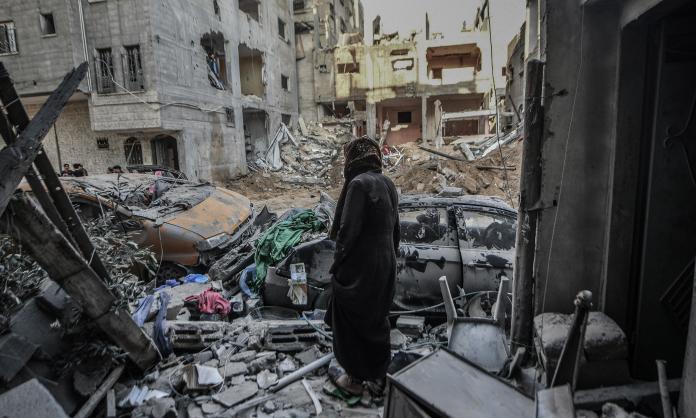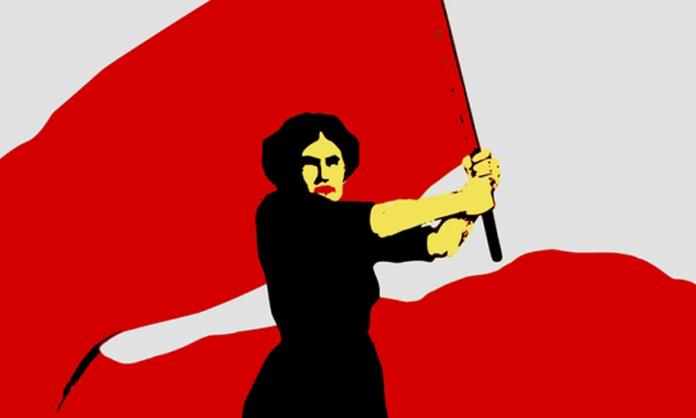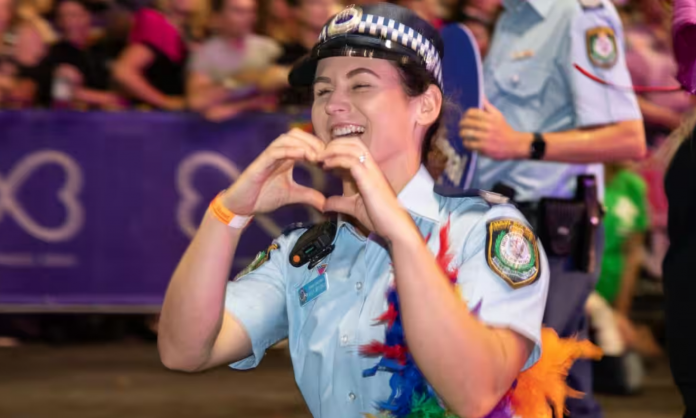“The Black Power movement shook the world; it certainly shook the roots of this country.”
– Jenny Munro
Redfern was centre of the Black Power movement in Australia during the 1960s and 1970s, when the Sydney suburb became a congregational point for Aboriginal people. In 1950, Redfern had an Aboriginal population of around 3,000. But by 1976, there were as many as 20,000 residing there. The large Aboriginal migration was in large part due to the greater freedoms city life had to offer. In rural New South Wales, segregation was still prominent, Aboriginal people being restricted from entering higher education and accessing social services.
“I finished year twelve and had no work in racist country towns and then headed to the bright lights of Sydney, as did lots of other young people”, Aboriginal activist Jenny Munro, who became active in those years, tells Red Flag. “Sydney was like a whole new world for us after the repression that we had grown up with in country towns. There was a whole lot more freedom down here. You could become anonymous in the city.”
City life, however, was still far from ideal. The Sydney social service categorised Redfern as a “slum”, most of the housing in the suburb being century-old, run-down terraces. In some cases, racist landlords would not lease to Aboriginal people. When Aboriginal people did get a lease, homes could become overcrowded with families and friends fleeing from the country.
Sydney police treated Aboriginal people in abhorrent ways. Historian Gary Foley, speaking to Red Flag in Melbourne, recounts that his “welcome” to the city was being grabbed and bashed by the 21st division squad. The racist harassment in Redfern was intensified after the Aboriginal Welfare Board closed in 1969, allowing the police to take a more central role in trying to control the population. Police raids at the Empress Hotel became a “mandatory practice” for the police, Foley recounts. Interrogations at the Empress were, Munro says, something “that defined the community for a long time”.
While Aboriginal people were dealing with harassment and poor housing, many tried to find employment in the hope of lifting their living standards in the impoverished suburb. However, this often proved difficult. About 22 percent of Aboriginal people in Sydney were officially unemployed in 1973, but only about one-third of them received unemployment entitlements. There were limited educational opportunities for Aboriginal people, resulting in many being employed only as unskilled labourers. Those employed in unskilled jobs had an average weekly take-home pay of less than $70, while the national average was $84.70. Many Aboriginal people became builders labourers, working on construction sites. Some, such as Kevin Cook and Monty Maloney, became members of the NSW Builders Labourers Federation.
When Aboriginal people could not find work, they were sometimes assisted by various community organisations, such as South Sydney Community Aid, the Redfern All Blacks rugby team and the Foundation for Aboriginal Affairs, which offered welfare support while promoting Indigenous rights.
By the early 1970s, Redfern had become a dynamic urban Aboriginal community, which extended out towards Waterloo, Alexandria and even Newtown. In dealing with the poor housing and social conditions and incessant racism from the police, the space for Aboriginal activism to explode and challenge Australian racism was opening. But there were differences of opinion regarding the best way forward.
Roberta “Bobbi” Sykes, in a debate with Senator Neville Bonner, argued that Black Power meant Black capitalism (Aboriginal people working their way up the capitalist system and pecking order), blood and guts (fighting in the streets, riots and looting) or Black action—Aboriginal people identifying, controlling and solving their problems and those of the community. Sykes asserted that Black Power for Aboriginal people meant the last, striving towards self-determination.
Sykes’ understanding of Aboriginal Black Power was shared by other Black Power activists, who also had their own distinctive interpretations. John Newfong viewed Black Power as a modern, urban ideology that was to tackle issues regarding modern Australian society. Munro views it as the maintenance of “Black knowledge” and “Blackness”. Likewise, other activists stressed the importance of cultural and spiritual revival that Black Power had to offer. Foley thought Black Power had to be rooted in political and economic demands. Paul Coe viewed it as the need for Aboriginal people to “take control both of the economical, the political and cultural resources of the people and of the land ... so that they themselves have got the power to determine their own future”.
While the Redfern activists had a shared commitment to Indigenous self-determination, they did not establish a unified ideological outlook. Foley recounts that Black Power activists used to steal books from Bob Gould’s Third World bookshop, until Gould started to give a discount to Aboriginal people. The Black Power activists read the likes of Malcolm X, Marcus Garvey, Frantz Fanon, Angela Davis, Jean Paul Sartre and more. Reading such activists and intellectuals enabled the Black Power activists to engage with a variety of politics—from the anti-colonialism of Fanon to American Black nationalism, communism, anarchism and Maoism.
The US Black Panther Party was a major inspiration for Redfern Black Power activists. Some of them had even met the Panthers in the US, through meeting and organising with Caribbean activist and academic Roosevelt Brown. Brown visited Redfern when he came to Melbourne in 1969 and offered some of the activists an invitation to the Congress of African People in Atlanta the following year. Activists such as Bob Maza and Sol Bellear joined the trip, and visited the Panthers in Harlem, New York. The visit inspired the Redfern activists and taught them a lot about the Panthers’ community programs centred on health and education, and confrontational tactics against the police.
Unlike the US Black Panther Party, the Redfern Black Power activists did not form a party with a view to challenging Australian capitalism. However, in Brisbane 1971, an Aboriginal Black Panther Party was formed, adhering to the model and politics of the US party, with an aim of overthrowing Australian capitalism. Activists like Foley and Paul Coe became members of the party and helped with its operations.
In developing Black Power in Australia, the Redfern activists also looked towards previous Aboriginal activists such as Fred Maynard, William Cooper, Doug Nichols, Bill and Eric Onus, Bill Ferguson and Jack Patten. Such activists had established various organisations, like the Australian Aborigines League, and held protests like the Day of Mourning action in 1938. Bill Onus and Ferguson were incredibly influential for the Redfern activists, as they had politically organised and fought around issues of Aboriginal land and legal rights.
In particular, the campaign for the 1967 referendum provided an important lesson for the Redfern activists.
More than 90 percent of Australians voted to include Aboriginal and Torres Strait Islanders as a part of the population and for the federal government to make laws about them. The referendum’s success was put down to ten years of campaigning by the Federal Council for the Advancement of Aborigines and Torres Strait Islanders, the Australian Aborigines League, the Aboriginal-Australian Fellowship and the Aborigines Progressive Association. While the referendum achieved progress in gaining legal representation for Aboriginal people, it was still insufficient to achieve greater social gains.
Foley says that the federal government “sat on their hands and did nothing” after the referendum, believing that they had done enough to meet the demands of Aboriginal people. But the Redfern activists knew that they needed to develop their own tactics and strategies that were different to those of previous generations of activists. The younger generation, Foley says, was dealing with a different set of issues. They wanted more political agitation, action and militancy to achieve things like land rights and self-determination—the Australian capitalist state was not going to improve Aboriginal life of its own accord.
The week after being beaten up by the cops, Foley met Paul Coe at the Wayside Chapel, which he describes as “a lively nest of everything from bikies and Hell’s Angels, through to hippies and revolutionaries, and Christian folk amongst the mix”. Foley asked Coe where he was from and was living. Coe reached into his pocket, pulled out a toothbrush and said, “Wherever this is”. Foley told Coe about his dealings with the police, at which point Coe did two things:
“He handed me a book and said ‘Read this’. The book was the autobiography of Malcolm X. Then he told me about how he was also dirty on the coppers in Redfern because as it turned out, his cousin had been shot by police in 1963 on Sydenham station. That event had politicised him. So, he said to me, ‘We want to do something about these fucking coppers’. And I said, ‘What can we do?’ And he said, ‘Well the first thing we can do is to get together and have a yarn about it’.”
Activists such as Billy Craigie, Isabel Coe, Alan Doolen, Tony Coorie, Gary Williams, Lyn Thomson, and others joined the discussion about the police. “This became the core of the Black Power movement in Redfern. The issue that brought us together, ironically, was police harassment, police brutality”, Foley says.
The Redfern activists took inspiration from the Black Panthers’ “pig patrol” initiative. The Panthers in America had found a loophole in California law that allowed them to carry firearms if the weapons were not concealed. So, with their guns out, they followed police patrols in an attempt to intimidate them out of harassing Black people. The Redfern activists couldn’t carry firearms, but the basic premise of monitoring the police to help the community tackle harassment was taken up. Foley describes the Redfern activists “follow[ing] the coppers with a pencil and book” to note down police officers’ numbers and licence plates. They could then keep track of police raids and the cops’ general movements in Redfern.
Through the pig patrol, the Redfern activists were beginning to organise themselves politically. And they were able to rally Aboriginal people through protests and provision work. Pig patrol gained the attention of then dean of the law faculty at the University of NSW, Hal Wotton. Paul Coe was a student under Wotton, and the Black Power activists invited him to visit them. “Once he saw Redfern, he assisted us in pulling together a team of young radical lawyers. We then set up the first free, shopfront legal aid centre for anyone in Australia”, Foley recalls. The collaboration of the Black Power activists and Wotton helped set up the Aboriginal Legal Service (ALS) in 1970.
Other services were soon created; the Aboriginal Medical Service (AMS) in 1971, and the Murawina Aboriginal preschool and the Aboriginal Housing Company (AHC) were both established in 1973. “The Block” became a point of community unity, as the housing was over time purchased by the AHC for Aboriginal-managed housing. The Block became an affordable source of low-cost housing for disadvantaged Aboriginal people, acting as a counterweight to the private housing market.
Aboriginal people had received little to no assistance from the NSW state or federal governments in dealing with day-to-day needs. For Aboriginal people deprived of basic health and social necessities, services like the ALS and AMS established a base level of aid. However, such services had political limitations. As service providers, even very good ones, they didn’t aim to tackle the capitalist system generating the gross inequalities. The bodies would later be corroded and bureaucratised.
The Black Power activists were situated in a time of mass radicalisation, during which they engaged in a variety of protest movements. They began working closely with the Builders Labourers Federation, in particular with the union’s fight to save buildings in Victoria Street, Sydney, from being bought by private developers. Foley remembers BLF people like Bob Pringle and Joe Owens being “close comrades and staunch supporters”.
Alongside the BLF, the Redfern activists were involved in the 1973 cotton chippers’ strike in the town of Wee Waa. Michael Anderson and Billy Craigie went to support the strike, while Paul Coe and Sol Bellear provided legal support for the arrested strikers. The Redfern activists’ connection to the strikers was important in breaking down racism and demonstrating the solidarity between activists in city areas and working-class people in rural regions. The strikes, with an array of support and militancy, were able to increase pay and introduce double time for Saturday and Sunday work, a massive win for the cotton workers.
The connections between the Redfern activists, the BLF and the strike in Wee Waa showcases the dynamic solidarity the workers’ movement can have with Aboriginal struggle. The Wee Waa strikers and the BLF’s unity with the activists in Redfern cut down the racist division between Indigenous and non-Indigenous people, turning attention towards fighting the bosses of private developer companies and racist politicians and institutions.
In 1971, the South African Springbok rugby team toured Australia, and the Redfern activists, alongside the anti-apartheid campaign, prepared protest stunts to illustrate the barbarity of the South African apartheid system. Actions included storming fields and even interrogating members of the Springbok team, which was staying at the Squire Inn, close to the Redfern activists’ communal “Black Power” house. Foley and others donned South African jerseys and entered the Squire Inn to confront the players. After the Springboks’ departure, members of the anti-apartheid campaign, in conjunction with the Gurindji land rights campaign, called for a march against racism and left the organising of the march to the Redfern Black Power group.
The 1971 Springbok tour enabled the Redfern activists to highlight the parallels of South African and Australian racial policies and also helped the Redfern activists to prepare for one of the greatest political protests in radical Australian history. In response to Liberal Prime Minister Billy McMahon’s denial of land rights, Billy Craigie, Tony Coorie, Michael Anderson and Bertie Williams were driven by Communist Party photographer Noel Hazzard to Canberra to erect a beach umbrella on the lawns outside Parliament House, in what was the beginning of the Aboriginal Tent Embassy. The idea behind the embassy, Foley says, was to show that “Aborigines were treated like aliens in their own land”. Students at the nearby Australian National University opened their union building for support activities, while members of the BLF and the Communist Party visited the embassy in solidarity.
The government ordered the police to remove the protesters. Jenny Munro recalls that when they moved in, the cops “didn’t care if anyone got hurt”. In response, more than 2,000 Aboriginal people, socialists and left-wing activists staged one of the biggest land rights demonstrations in Australian history on 30 June 1972. Unfortunately, after the Tent Embassy protest, the NSW government went on the offensive against Redfern. In April 1973, a Commonwealth grant for the purchase of 41 houses in Louis and Caroline streets was approved. This broke up the Redfern community. New regulations on public housing tenants were imposed, and, Foley says, “Aboriginal families were forced into the western suburbs of Sydney, one family per street as a return of the assimilation policy”. The offensive against Aboriginal people in the suburb has never really ended.
There are many lessons to learn from the Black Power movement in Redfern. Munro takes pride in the fact that the Black Power activists’ “training came from the streets, fighting the police in the big smoke”. This grassroots focus is something we must replicate today. Our politics and organising can’t be advanced by seeking out careers in the state and NGO bureaucracies or through reformist organisations that back the capitalist class. If we want power, we’ve got to fight for it.









